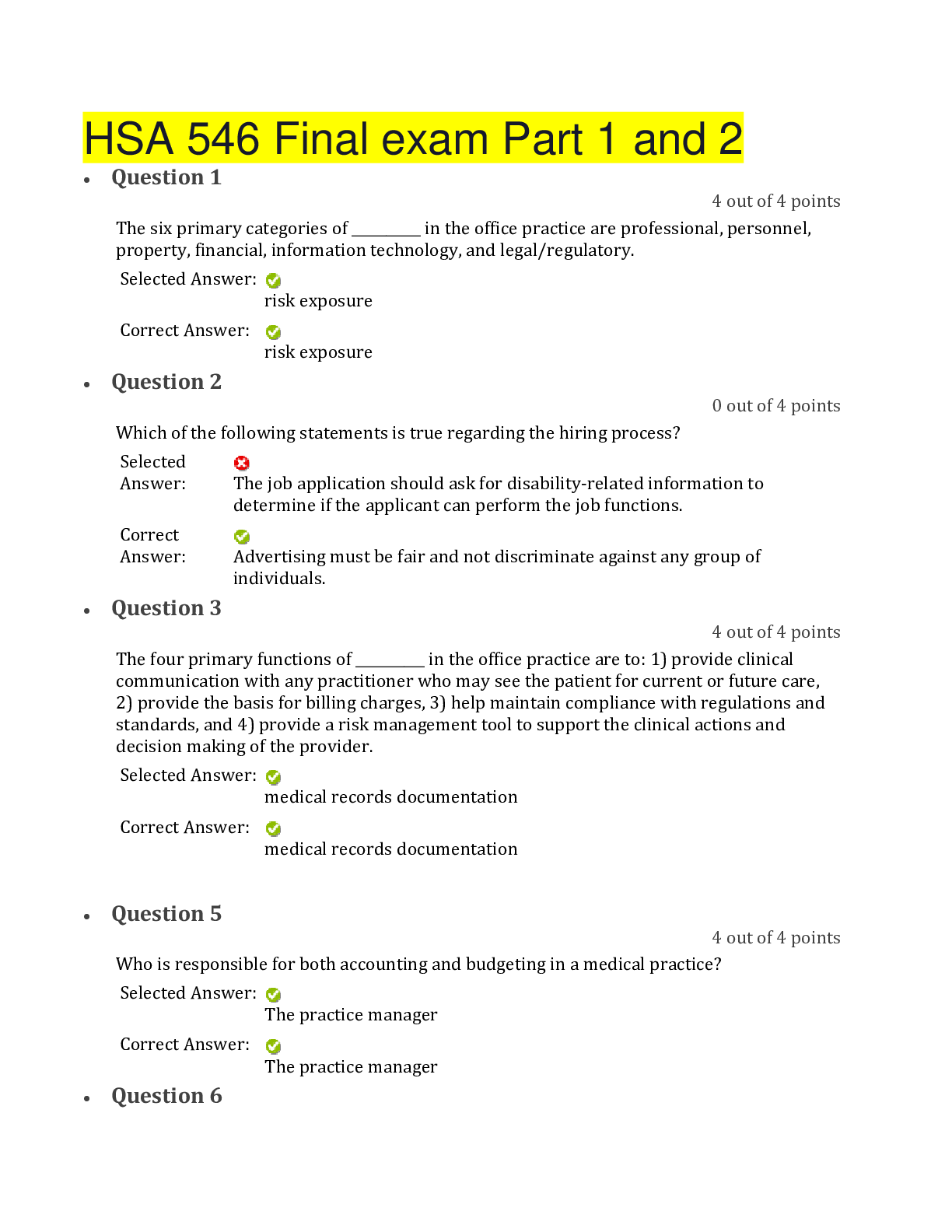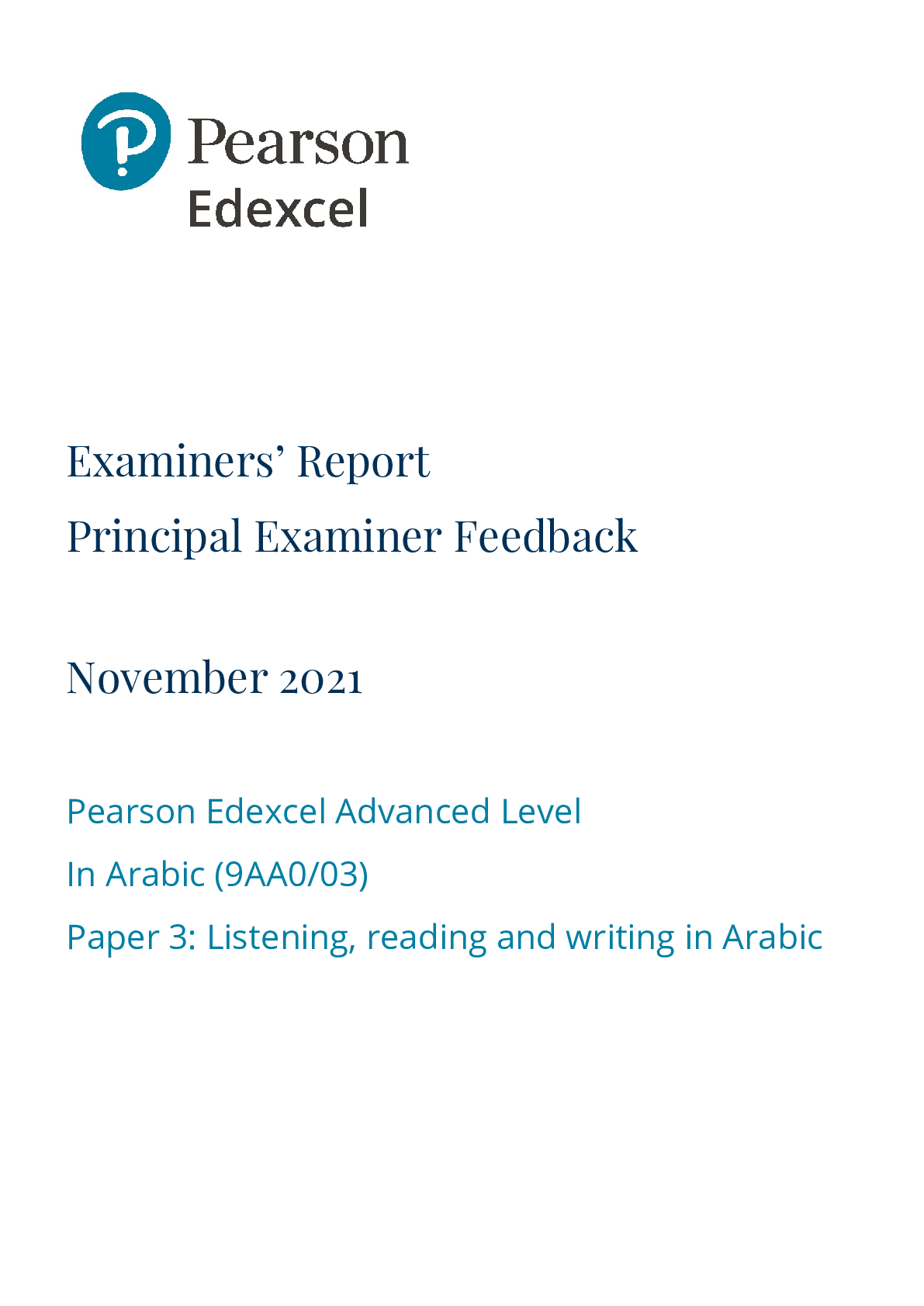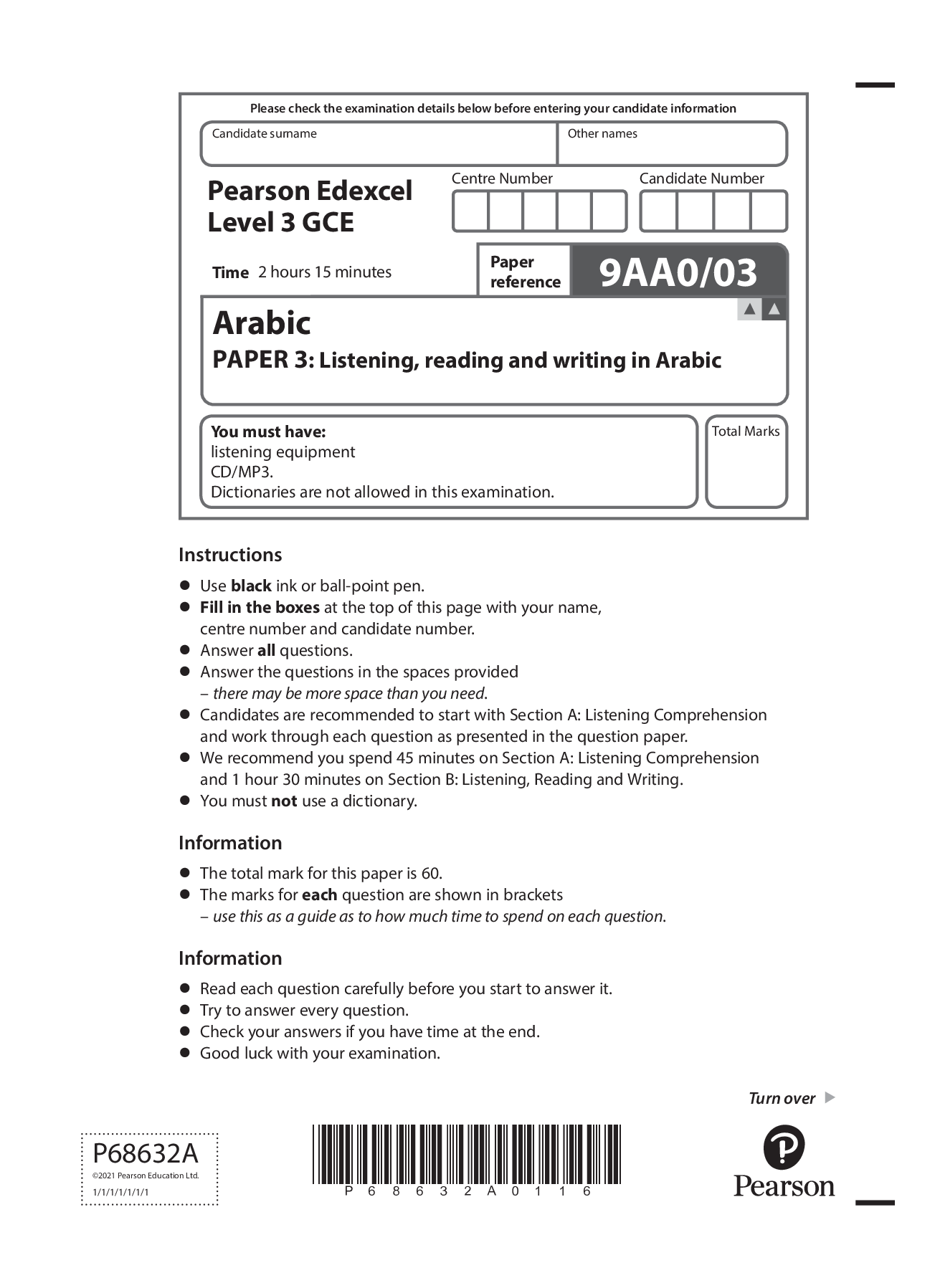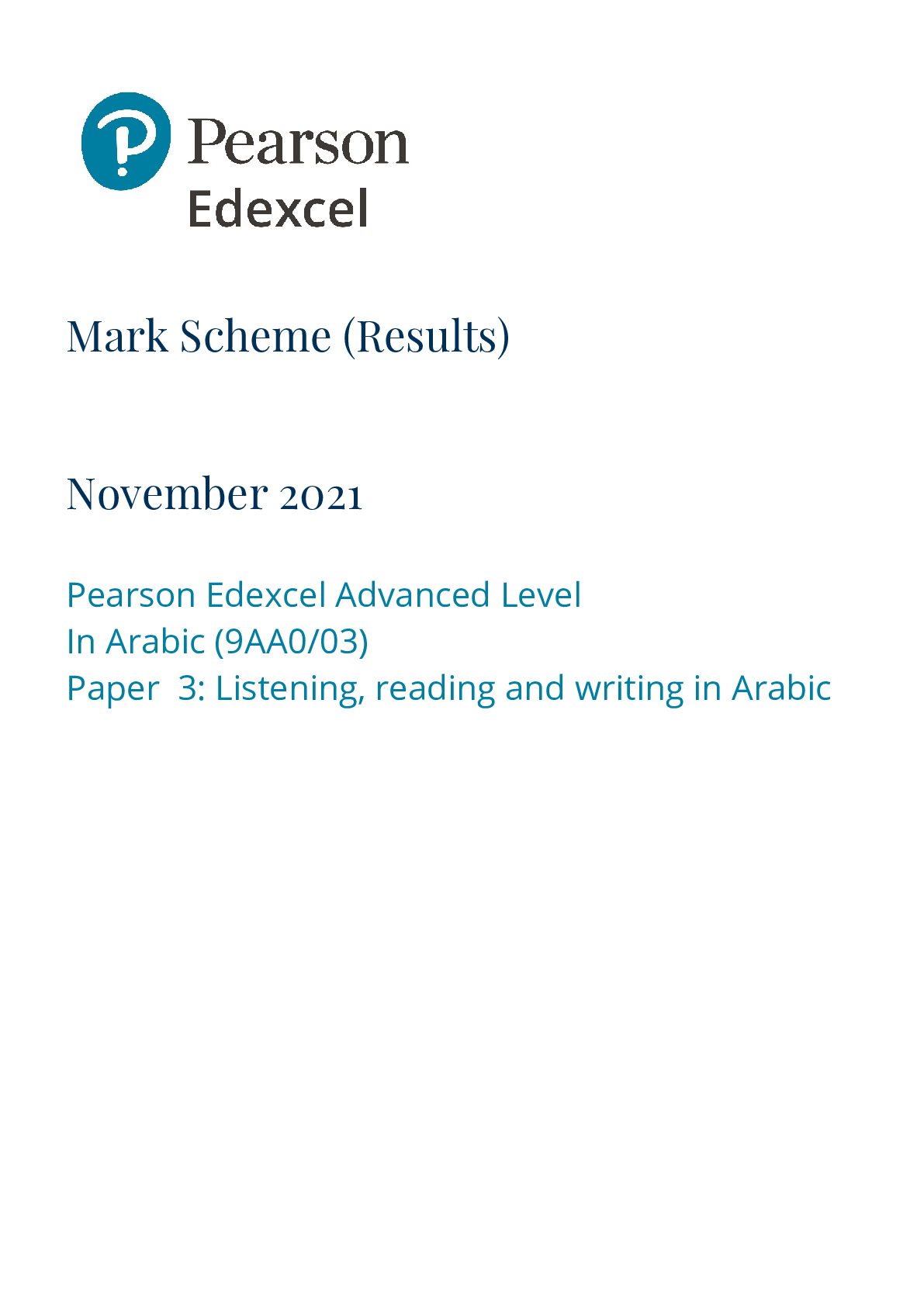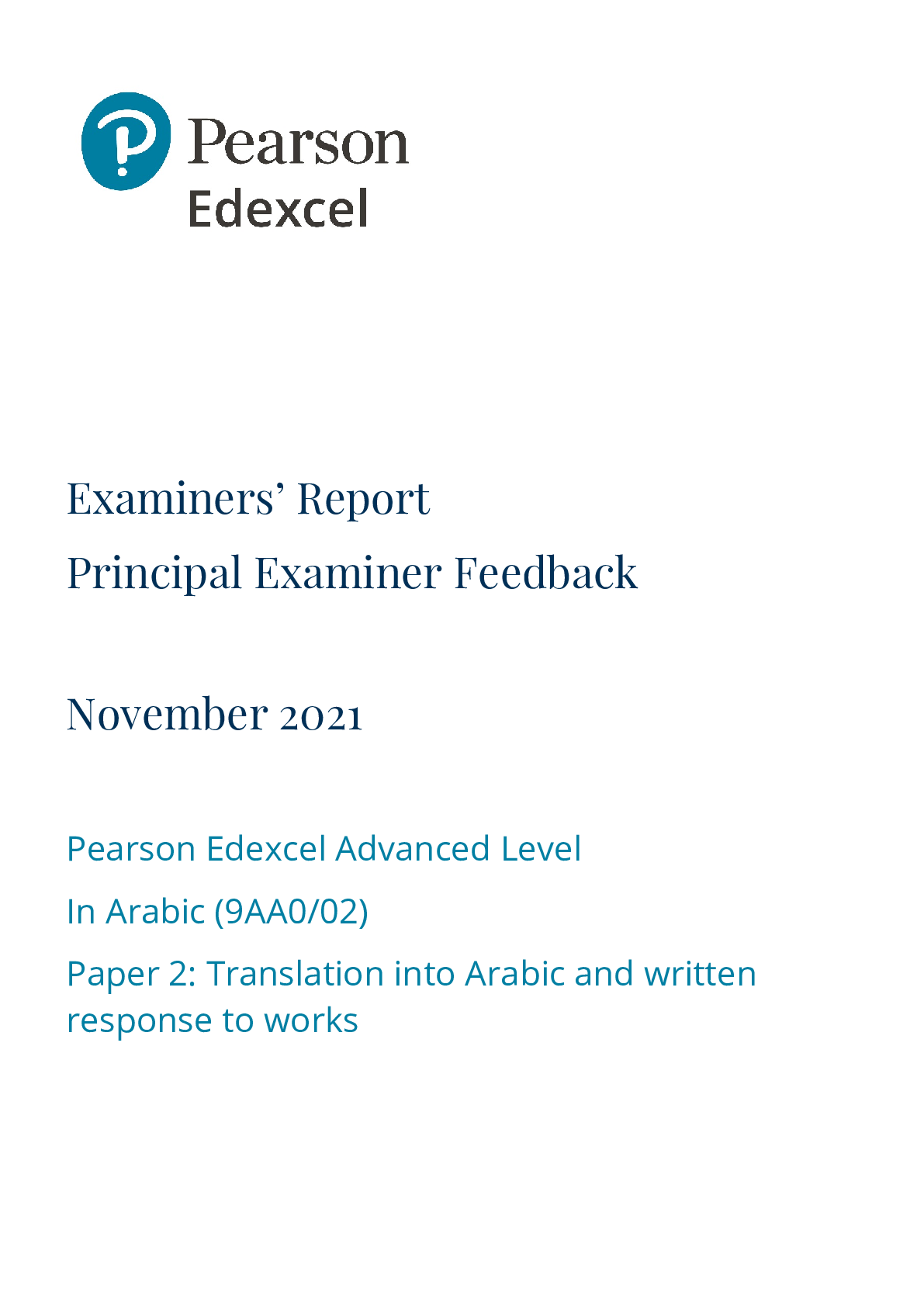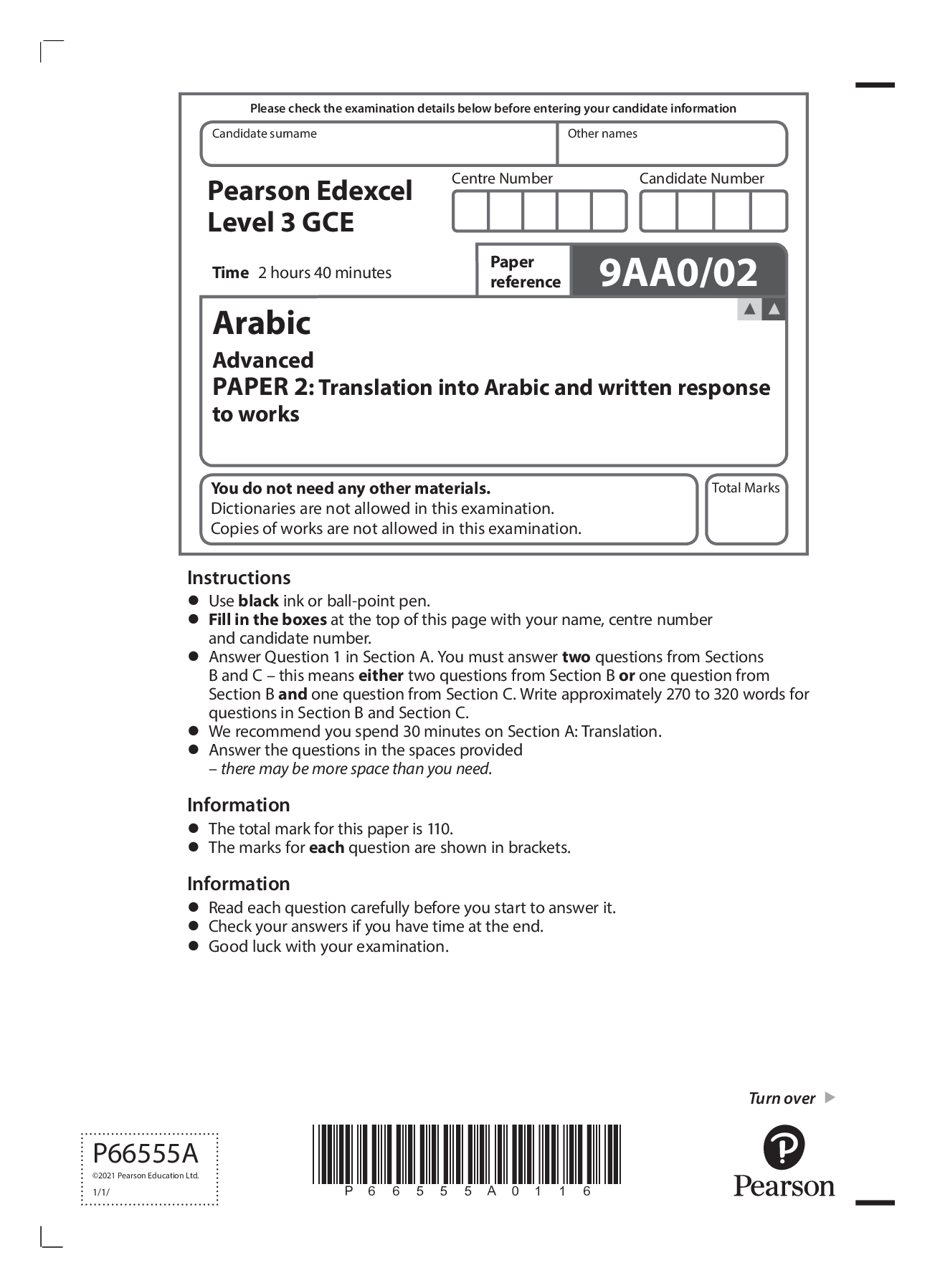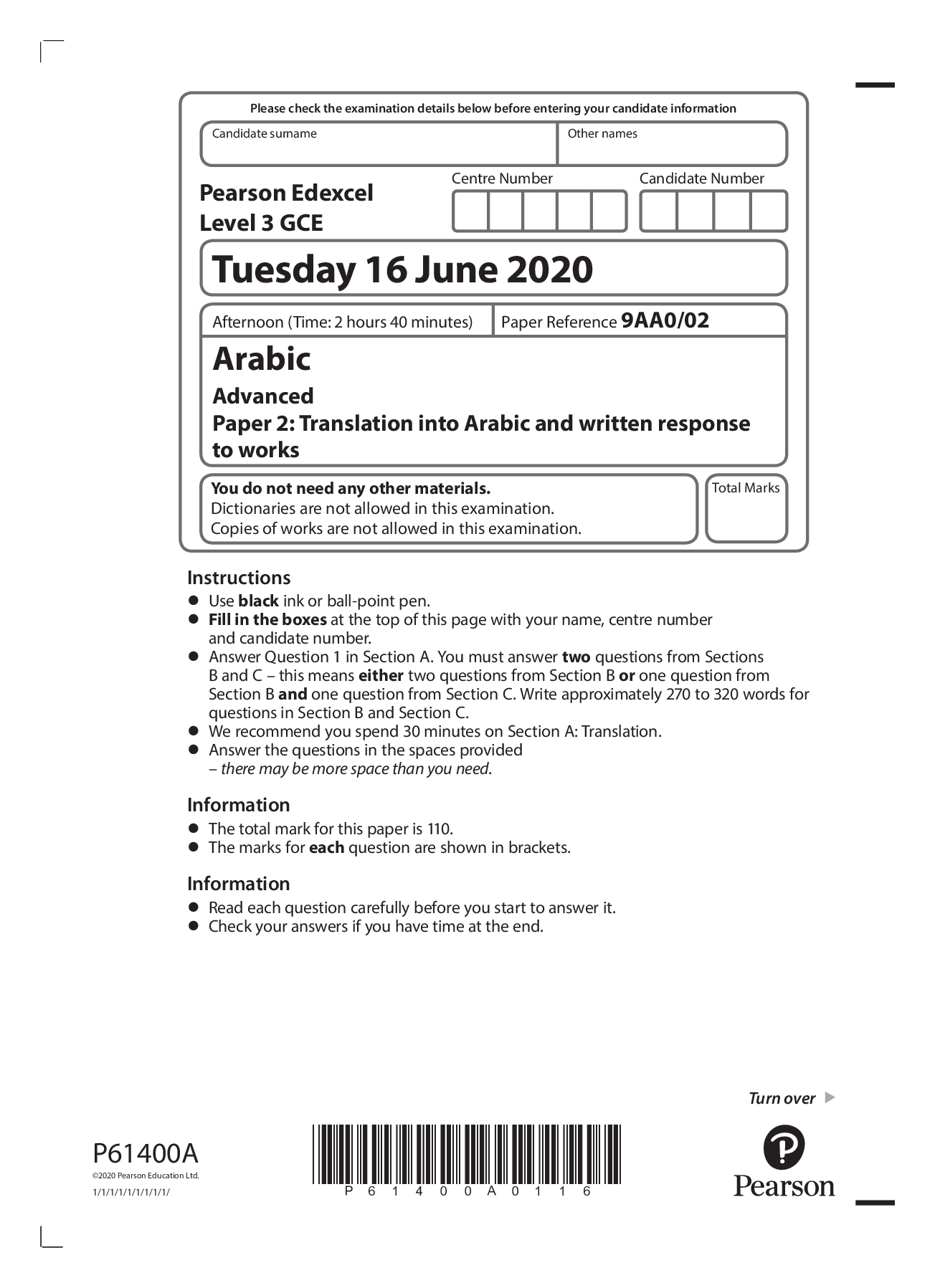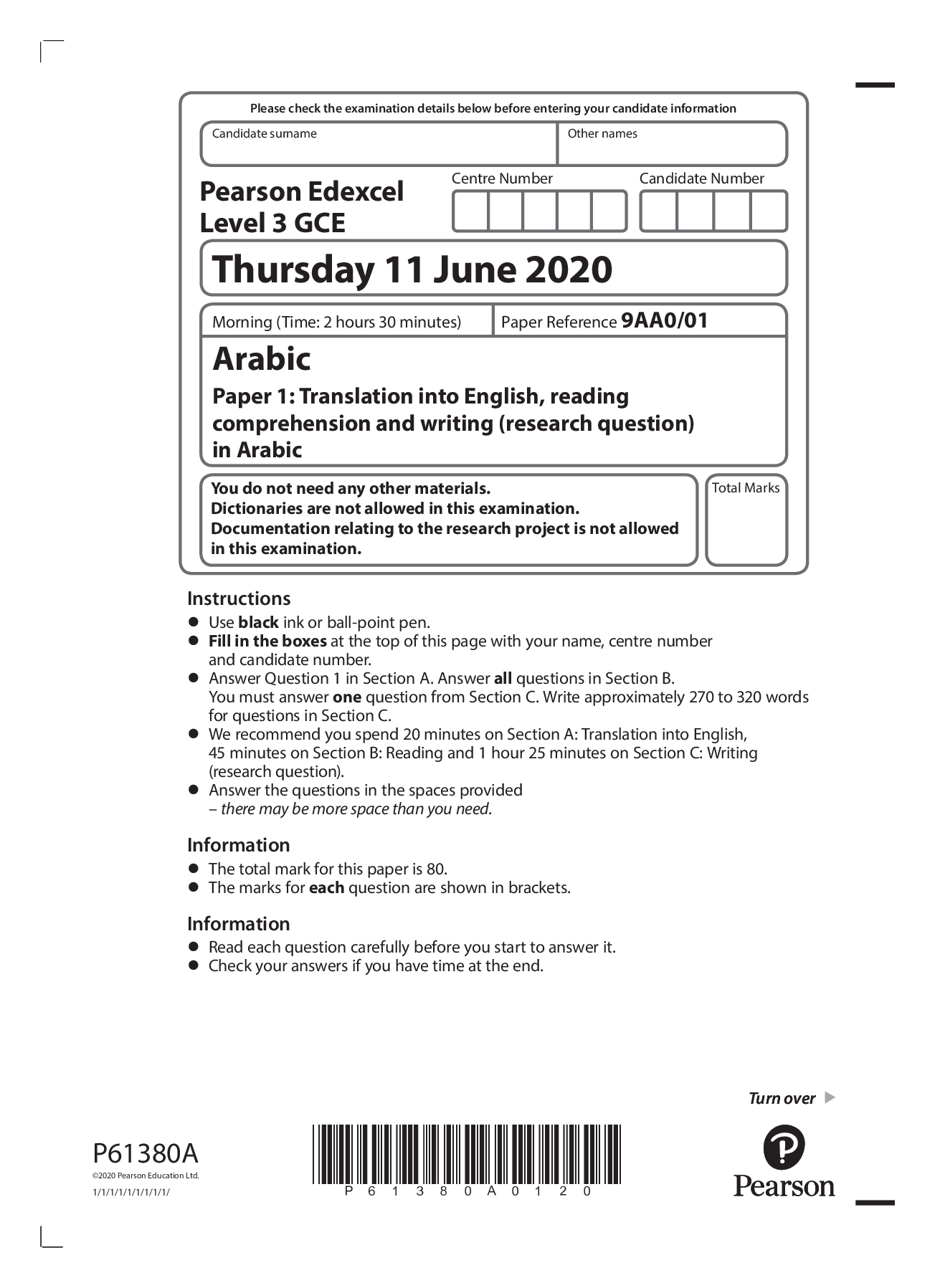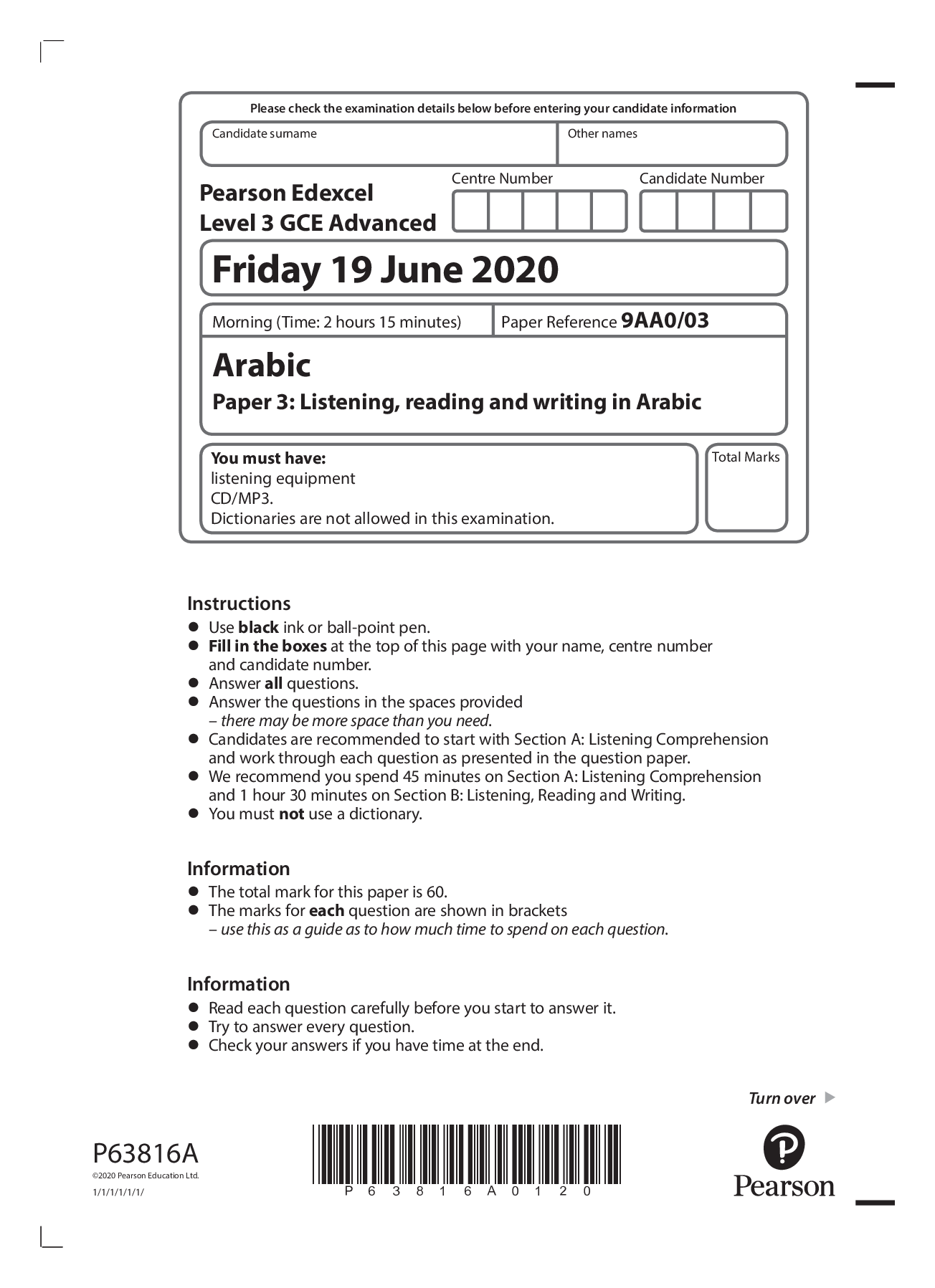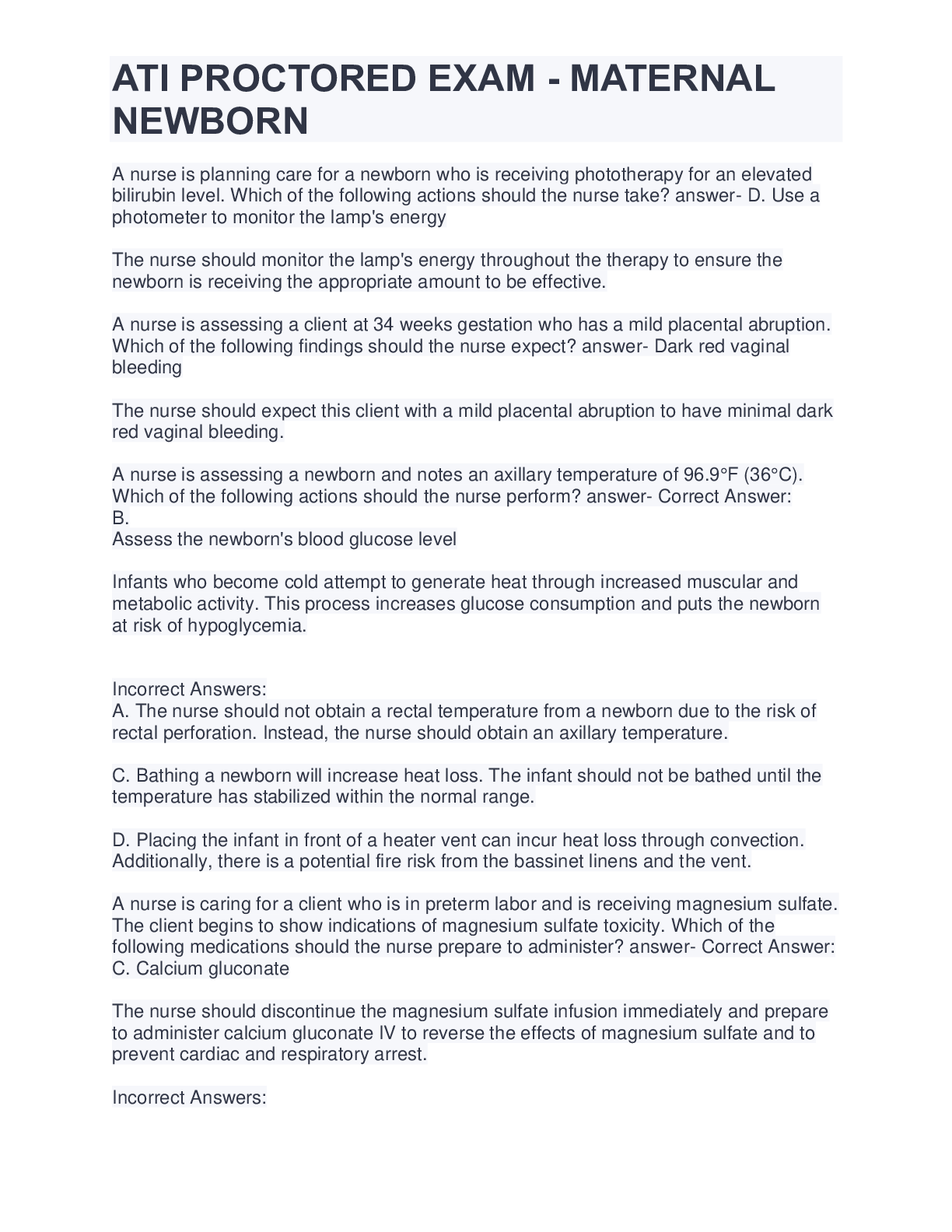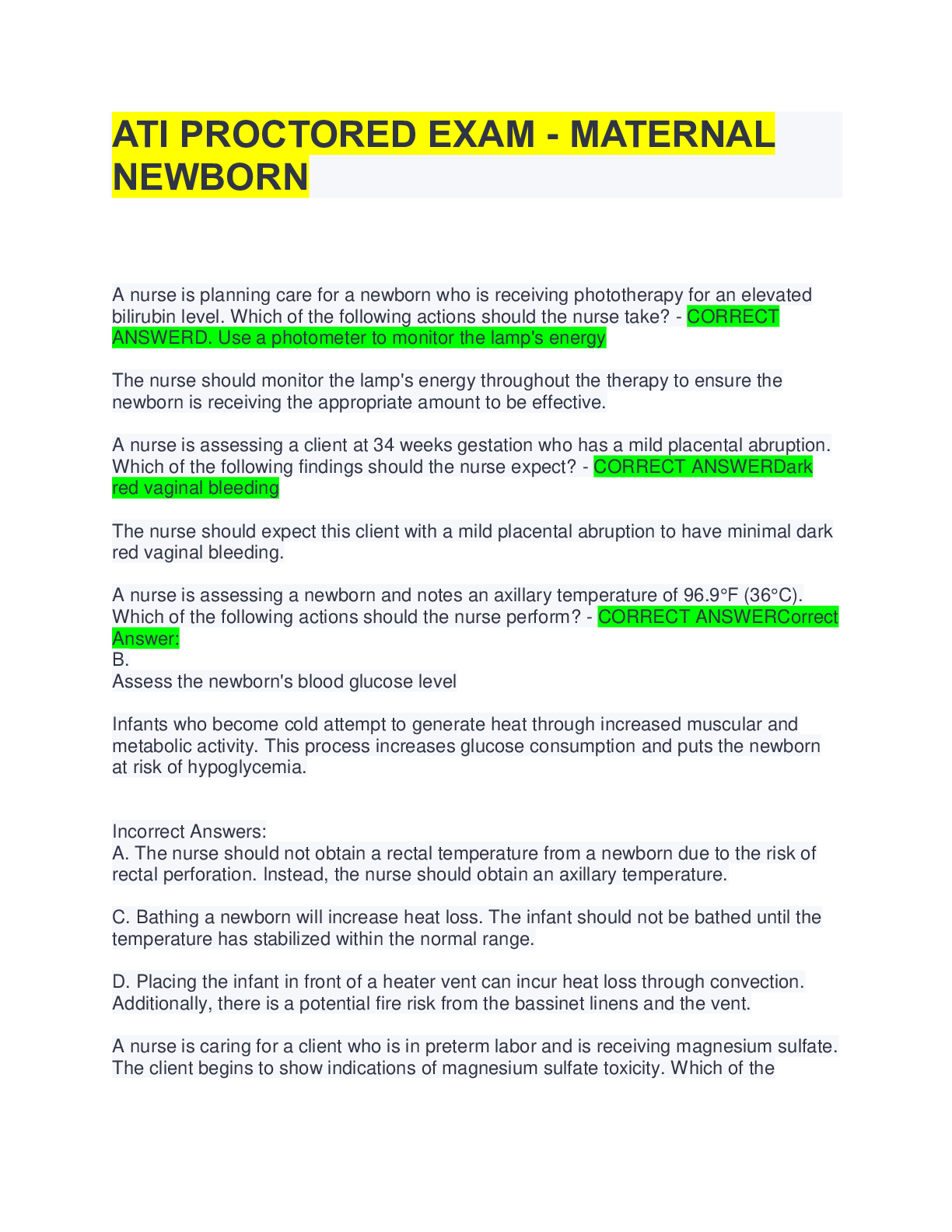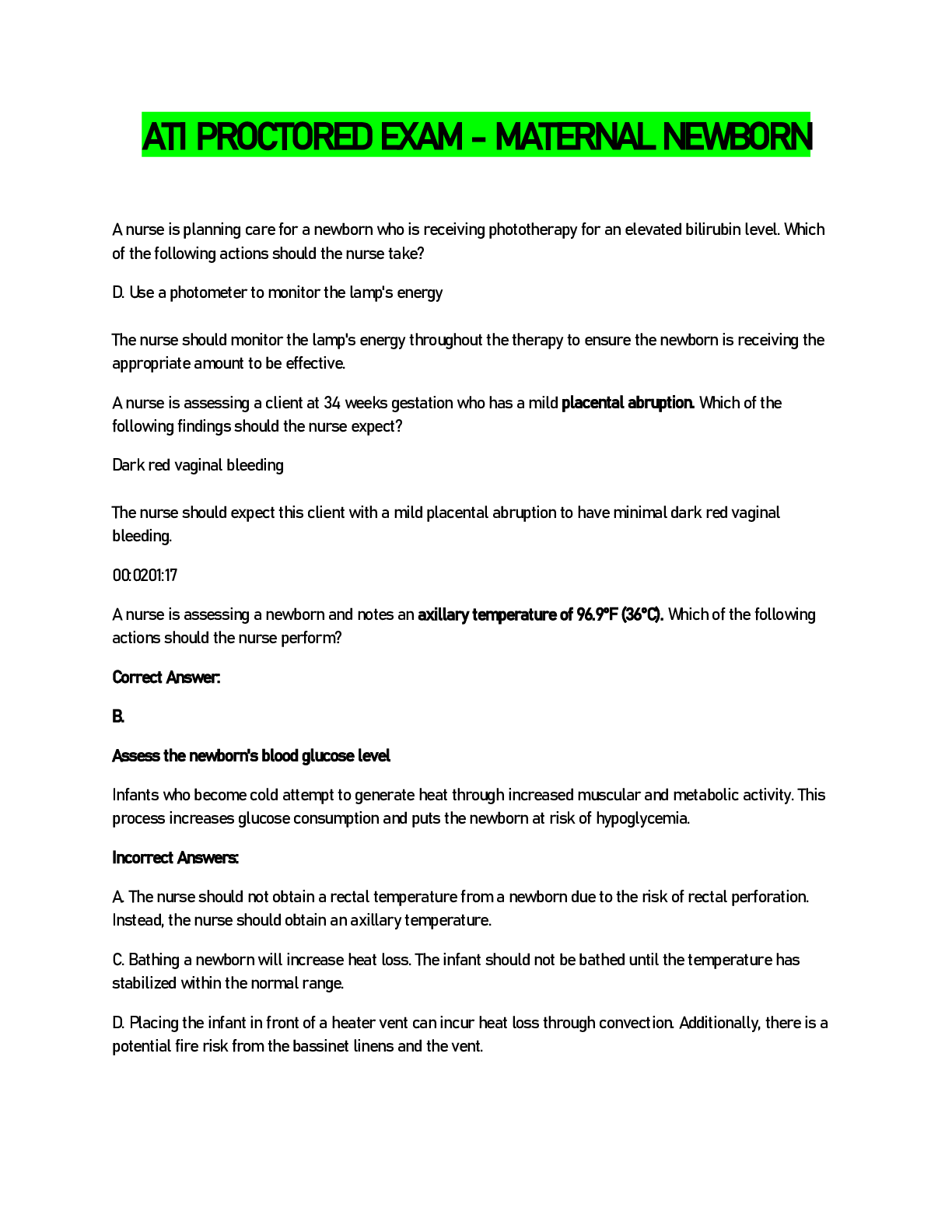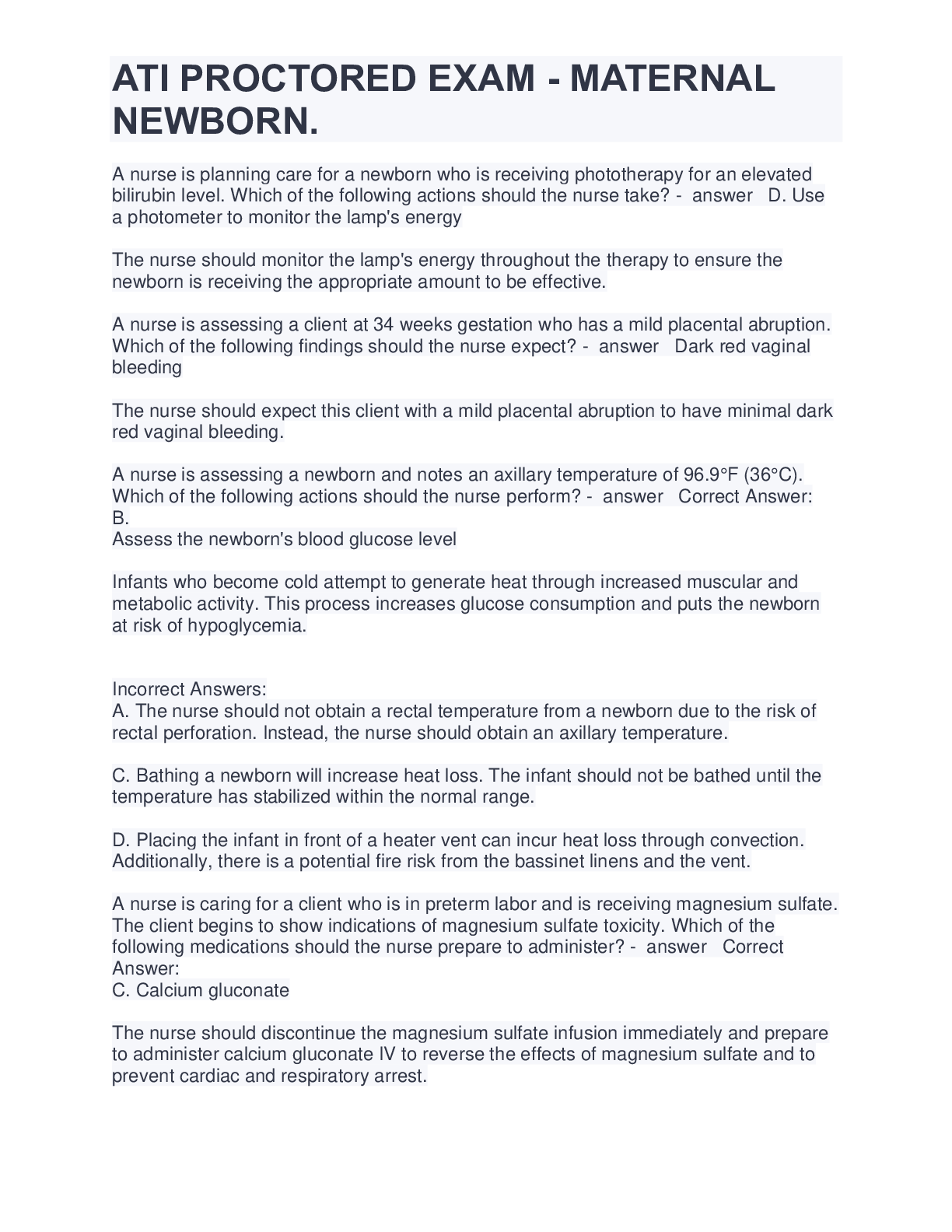Health Care > EXAM > ATI PROCTORED EXAM - MATERNAL NEWBORN (All)
ATI PROCTORED EXAM - MATERNAL NEWBORN
Document Content and Description Below
ATI PROCTORED EXAM - MATERNAL NEWBORN A nurse is planning care for a newborn who is receiving phototherapy for an elevated bilirubin level. Which of the following actions should the nurse take? -? ... D. Use a photometer to monitor the lamp's energy The nurse should monitor the lamp's energy throughout the therapy to ensure the newborn is receiving the appropriate amount to be effective. A nurse is assessing a client at 34 weeks gestation who has a mild placental abruption. Which of the following findings should the nurse expect? -? Dark red vaginal bleeding The nurse should expect this client with a mild placental abruption to have minimal dark red vaginal bleeding. A nurse is assessing a newborn and notes an axillary temperature of 96.9°F (36°C). Which of the following actions should the nurse perform? -? Correct Answer: B. Assess the newborn's blood glucose level Infants who become cold attempt to generate heat through increased muscular and metabolic activity. This process increases glucose consumption and puts the newborn at risk of hypoglycemia. Incorrect Answers: A. The nurse should not obtain a rectal temperature from a newborn due to the risk of rectal perforation. Instead, the nurse should obtain an axillary temperature. C. Bathing a newborn will increase heat loss. The infant should not be bathed until the temperature has stabilized within the normal range. D. Placing the infant in front of a heater vent can incur heat loss through convection. Additionally, there is a potential fire risk from the bassinet linens and the vent. A nurse is caring for a client who is in preterm labor and is receiving magnesium sulfate. The client begins to show indications of magnesium sulfate toxicity. Which of the following medications should the nurse prepare to administer? -? Correct Answer: C. Calcium gluconate The nurse should discontinue the magnesium sulfate infusion immediately and prepare to administer calcium gluconate IV to reverse the effects of magnesium sulfate and to prevent cardiac and respiratory arrest. Incorrect Answers: A. Protamine sulfate helps reverse the effects of heparin, not magnesium sulfate. B. Naloxone is an opioid reversal agent. It does not reverse the effects of magnesium sulfate. D. Flumazenil reverses the effects of benzodiazepines such as lorazepam and alprazolam, not magnesium sulfate. A nurse is providing postpartum discharge teaching to a client who is non-lactating about breast discomfort relief measures. Which of the following pieces of information should the nurse include? -? Correct Answer: "Place fresh cabbage leaves on your breasts." After 3 days postpartum, the client's breasts can become swollen and distended because of congestion of the vascular structures of the breasts. Fresh cabbage leaves can be applied to engorged breasts to help relieve breast discomfort. The coolness of the leaves and the phytoestrogens exert a therapeutic effect on engorged breasts. Leaves should be replaced when they become wilted. Incorrect Answers: A. The client should be instructed to wear a tight-fitting bra or breast binders to alleviate engorgement and swelling. C. Application of warmth to the breasts should be avoided because heat can stimulate milk production. An ice pack should be used to relieve engorged breasts. D. Milk should not be expressed from the breasts. This intervention would increase milk production rather than decrease it. A nurse is educating a client who is at 10 weeks gestation and reports frequent nausea and vomiting. Which of the following statements should the nurse include in the teaching? -? Correct Answer: D. "You should eat dry foods that are high in carbohydrates when you wake up." The nurse should instruct the client to eat foods that are high in carbohydrates such as dry toast or crackers upon waking or when nausea occurs. Incorrect Answers: A. The nurse should instruct the client to eat foods served at cool temperatures to decrease nausea and vomiting. B. The nurse should instruct the client to avoid brushing her teeth immediately after eating to decrease vomiting. C. The nurse should instruct the client to eat salty and tart foods during periods of nausea. A nurse is providing postpartum discharge teaching for a client who is breastfeeding. The client states, "I've heard that I can't use any birth control until I stop breastfeeding." Which of the following responses should the nurse make? -? Correct Answer: D. "A progestin-only pill or injection is available for use while you are breastfeeding." Progestin-only injections, implants, and birth control pills are acceptable options for clients who are breastfeeding, although some experts recommend waiting until 6 weeks postpartum to initiate the medication. Incorrect Answers: A. Breastfeeding can inhibit ovulation or prolong menstruation; however, it is not a reliable and effective means of birth control. The client may experience an unplanned pregnancy if she waits until her periods resume before considering birth control options. B. Estrogen-containing birth control pills, implants, patches, and vaginal rings are not recommended for clients who are breastfeeding due to the risk of inhibiting breast milk production and supply. C. Condoms and other non-hormonal birth control methods are appropriate for clients who are breastfeeding; however, there are other methods that are also appropriate. A nurse is assessing a client who is receiving morphine via a patient-controlled analgesia (PCA) pump following a cesarean birth. Which of the following findings should the nurse report to the provider? -? Correct Answer: D. Urine output 20 mL/hr Opioid analgesics such as morphine can cause urinary retention. The client should have a urinary output of at least 30 mL/hr. The nurse should report this finding to the provider. Incorrect Answers: A. Opioid analgesics can cause respiratory depression. However, this respiratory rate is within the expected reference range. B. This temperature is within the expected reference range. C. Dizziness is a common adverse effect of receiving opioid analgesics. The nurse should instruct the client to sit on the side of the bed before getting up, assist the client with ambulation, and implement general safety measures. However, it is not necessary to report this finding to the provider. A nurse in a clinic is providing teaching to a client who is at 37 weeks of gestation and is scheduled for an external cephalic version. Which of the following statements should the nurse make? -? Correct Answer: B."You will receive a medication to relax your uterus prior to the procedure." A client who is scheduled to undergo an external cephalic version often receives a tocolytic prior to the procedure to allow the uterus to relax. A relaxed uterus allows an easier version by the provider. Incorrect Answers: A. This action is appropriate for internal version. With external version, the provider attempts to turn the fetus around externally and not internally. C. External version is a high-risk procedure that is performed in a hospital setting in the event of an emergency. D. During the external version, the fetal heart-rate pattern is monitored continuously because the fetus is at risk of bradycardia and variable decelerations. The nurse also monitors the fetal heart rate for at least 60 minutes following the procedure. A postpartum nurse is caring for a client who reports excessive sweating during the first night after delivery. Which of the following statements should the nurse make? -? Correct Answer: D. "This is a source of your fluid loss after delivery." Postpartum diuresis is the loss of the remaining pregnancy-induced increase in blood volume. The loss of excess tissue fluid begins within 12 hours after birth. Fluid loss by urination and perspiration results in a weight loss of approximately 2.27 kg (5 lb) during the early postpartum period. Incorrect Answers: A. Postpartum diuresis is attributed to decreased estrogen levels, the removal of increased venous pressure in the lower extremities, and the loss of the remaining pregnancy-induced increase in blood volume. B. Postpartum diuresis is caused by decreased estrogen levels. Fluid loss by urination and perspiration results in a weight loss of approximately 2.27 kg (5 lb) during the early postpartum period. C. Postpartum diuresis is caused, in part, by the removal of increased venous pressure in the lower extremities. Urine output can exceed 3000 mL/day during the first 2 to 3 days postpartum. The parents of a child with phenylketonuria (PKU) ask the nurse if their second unborn child could have the same condition. The nurse should base the response on which of the following inheritance patterns responsible for PKU? -? Correct Answer: C. Autosomal recessive PKU is inherited by autosomal-recessive gene patterns. In these types of disorders, neither parent may actually have the disorder, but both mother and father must carry and contribute a variant gene for it to occur. Other autosomal-recessive disorders are cystic fibrosis and sickle cell anemia. Incorrect Answers: A. PKU does not have an X-linked recessive pattern of inheritance. In X-linked recessive disorders, the abnormal gene is carried on the X chromosome. In males, only 1 copy of the abnormal gene is required for the disorder to be expressed in males since the Y chromosome does not carry the disorder. Females must have 2 copies of the gene. Examples of this type of disorder are hemophilia and color blindness. B. PKU does not have an X-linked dominant pattern of inheritance. In X-linked dominant disorders, the abnormal gene is carried on the X chromosome. Only 1 copy of the abnormal gene is necessary for the disorder to occur. However, males are more likely to be severely affected due to the homozygous expression. There are only a few disorders that follow this pattern of inheritance. Examples include vitamin D-resistant rickets and Rett syndrome. D. PKU does not have an autosomal-dominant pattern of inheritance. In these disorders, only 1 copy of the variant gene is necessary for the disorder to occur. Examples of this type of disorder are neurofibromatosis and Treacher Collins syndrome. A nurse is teaching a client about physiological changes that can occur with menopause. Which of the following changes should the nurse include? -? Correct Answer: C. Stress incontinence The nurse should teach the client that stress incontinence can occur due to the shrinking of the uterus, vulva, and distal portion of the urethra. Urinary incontinence and uterine displacement can occur because of common age-related changes but are not necessarily a result of menopause-related changes. Incorrect Answers: A. The nurse should teach the client that urinary frequency, not hesitancy, can occur due to the shrinking of the uterus, vulva, and distal portion of the urethra. B. The nurse should teach the client that hematuria is a manifestation of irritation to the bladder mucosa and might indicate a urinary tract infection. It is not an expected change associated with menopause. D. The nurse should teach the client that vaginal dryness can occur with menopause due to the vaginal walls becoming thinner and drier, delaying lubrication. This can lead to painful intercourse. A nurse is providing education about newborn skin care for a group of new parents. Which of the following instructions should the nurse include? -? Correct Answer: B.Sponge bathe the newborn every other day Daily bathing can disrupt the acid mantle of the newborn's skin and alter skin integrity. The parents should sponge bathe the infant until the cord stump has detached and the area has healed. Incorrect Answers: A. In uncircumcised males, the foreskin adheres to the glans of the penis. Parents should not attempt to retract the foreskin before the age of 3 years. Parents should wash the penis with soap and water. C. The parents should avoid using antimicrobial soaps and instead use soap with a neutral pH and no preservatives to protect the acid mantle of the newborn's skin. D. The parents should maintain the bath water temperature between 38° and 40°C (100° and 104°F). A postpartum nurse is caring for a client who is 4 hours postpartum and has a painful third-degree perineal laceration. Which of the following interventions should the nurse take? -? Correct Answer: Apply cold ice packs to the client's perineum A third-degree laceration extends from the perineum to the external sphincter of the rectum. This can cause severe discomfort. Cold ice packs are used on the perineal area during the first 24 hours to decrease edema, pain, and discomfort. Incorrect Answers: A. Warm sitz baths are appropriate after the first 24 hours postpartum. A cool sitz bath is recommended within the first 24 hours to reduce edema and promote comfort. B. The nurse should encourage the client to sit on firm surfaces. The client should avoid soft pillows and donut pillows because they separate the buttocks and decrease venous blood flow, resulting in more pain and discomfort to the perineal area. D. The use of suppositories or enemas is contraindicated for a client who has a third-degree perineal laceration due to the severity of the laceration. ............................ [Show More]
Last updated: 1 year ago
Preview 1 out of 43 pages
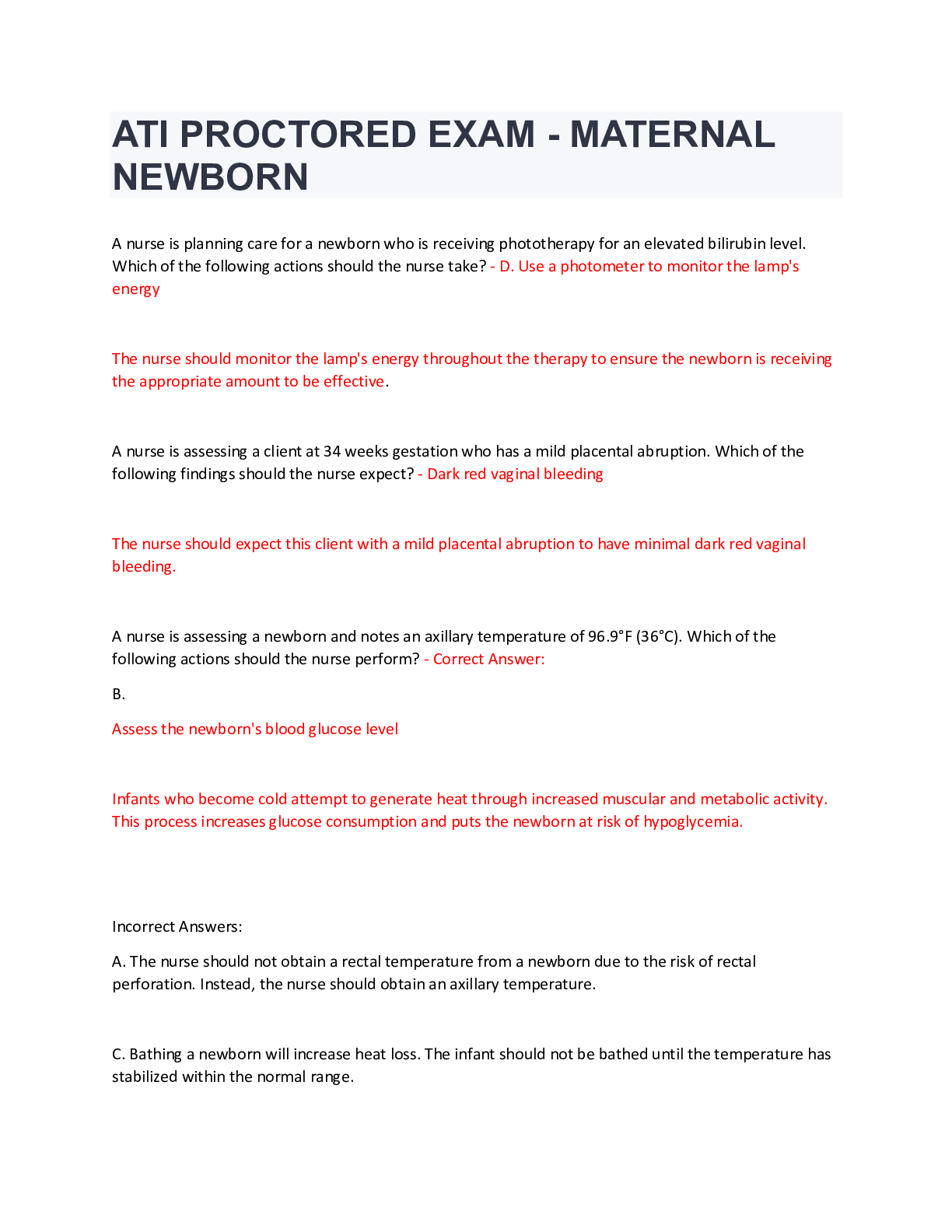
Reviews( 0 )
Document information
Connected school, study & course
About the document
Uploaded On
Apr 19, 2022
Number of pages
43
Written in
Additional information
This document has been written for:
Uploaded
Apr 19, 2022
Downloads
0
Views
76

